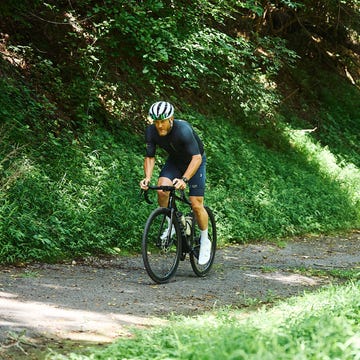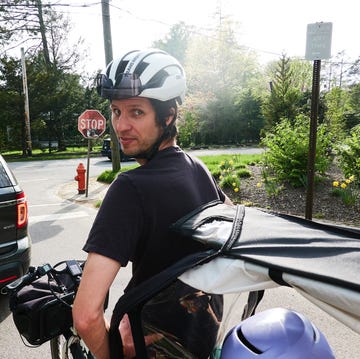Whether you’re a cyclist who rides year-round regardless of what the weather forecast is, or you prefer the warmer months but still head out for an occasional winter fat bike ride in the snow, the cold season can wreak havoc on the body’s biggest organ. But it’s easy to sidestep any issues with a little know-how and preparation. Take it from us: don’t wait to nurture your skin against the elements until after your winter rides.
“Most of my patients are 60 years old and have been outdoorsy their entire life. They say, ‘If I only knew.’ There are decades of lag time with sun exposure,” says Meghan Kennedy, MSPAS, MPH, PA-C, a physician assistant who specializes in dermatology at Solano Dermatology Associates. “Don’t wait until a couple of decades later, after you develop damage. Prevention is the key to medicine.”
To help you prevent (and treat) skin problems that tend to pop up in winter, here are tips from skin specialists and cycling field experts who share their recommendations for taking care of these seven common winter skin issues.
Skin Condition: Cold Sores and Chapped Lips
Cold sores, also known as fever blisters or herpes, are a cluster of tiny, painful blisters that often surface on the outside of the lips, but can also form on the nose or cheeks. The combination of a long ride, ample sun exposure, and getting chapped and windburn can trigger cold sores, says Kennedy.
Prevention
Use a moisturizing SPF 30 lip balm and reapply often to prevent those windburned, chapped, sunburned lips. “Quality formulations include Sun Bum lip balm and EltaMD UV Lip Balm Broad-Spectrum SPF 36,” notes Kennedy. Continue to keep lips moisturized at home. “Running heaters at home dries out the air, so chapped lips can persist,” she adds.
Treatment
Cold sores can be treated with an antiviral medication. In more severe cases, “people that frequently get cold sores can take a prescribed prophylactic antiviral medication like Valtrex before they ride,” says Kennedy. If put on the back-burner, “over the years people can develop sun damage that mimics chronically dry, scaling chapped lips that’s mostly precancerous. The treatment is then uncomfortable—erosive creams or freezing it off—whereas someone younger could be treated with steroid cream,” says Kennedy.
Skin Condition: Windburn
Windburn, a reddening and soreness of the skin that leaves skin more susceptible to sun damage, can get worse in winter.
Prevention
Windburn is best prevented by placing a thin layer of a barrier ointment, like Vaseline, Aquaphor, or a thicker cream like CeraVe on the skin, before you start pedaling, says Janiene Luke, M.D., dermatologist with Loma Linda University Health.
In step with Dr. Luke’s guidance, cycling apparel designer Barb Howe, who consistently bike commutes, spreads on Dermatone Lip and Face Stick. She also designs and dons wind-blocking cold-weather apparel accesories for weather-exposed ears, face, and neck, like Pearl Izumi’s AmFib Lite Balaclava, Skull Cap, and Headband.
Treatment
“Treatment is essentially the same as prevention: thick moisturizer. Use ones that contain humectants such as hyaluronic acid or glycerin and emollients with fatty acids such as ceramides,” says Kennedy. “In extreme weather or post windburn, you may want to double down and use something ‘greasier’ such as CeraVe Healing Ointment or Aquaphor Healing Ointment. Also, avoid irritants in the healing period (several days) including acne creams and washes, anti-aging treatments and after shave.”
Skin Conditions: Saddle Sores and Chafing
As the Disneyland Resort entertainment stage technician, cyclist Lindsey Bryant pedals several daily miles resort-wide even during wintertime’s dry, cold 30-degree lows. Because of these conditions, her cotton work uniform can chafe and cause chapped skin along the thighs and backside.
Bryant isn’t alone. Sit bones and nether regions can get irritated with saddle sores while riding during the winter due to layered cold-weather apparel causing increased friction while pedaling. “There’s more potential for discomfort with non-svelte outfits. Compressed tissue on the saddle and moving up and down with the legs can be abrasive,” explains Josh Whitmore, an expert-level cycling coach and former cross-country mountain bike racer.
Chafing can also occur from continuous rubbing against irritating fabric, resulting in a stinging sensation and mild rash. Severe chafing can even lead to swelling, bleeding, or scabs.
Prevention
Apply chamois cream, such as Chamois Butt’r, to minimize friction around your nether regions, and apply a product like Bodyglide between clothing layers and skin where rubbing exists, advises Kennedy. “Powders, especially if you tend to sweat, will clump and lose their gliding effect. Make sure your saddle fit is correct so it doesn’t rub the wrong way and don’t wear underwear.” Every cyclist may need to do some trial and error to figure out exactly what works for them, she adds.
To mitigate shifting seams, Howe recommends a cold-weather layering strategy pairing high-quality, well-fitting, and moisture-wicking cycling bibs or shorts with a chamois with a winter-shielding outer layer of thermal cycling tights. “Thicker tights with a chamois have a tendency to shift around,” which can lead to wrongful rubbing, she notes. “I wash the bibs every night and reuse the tights,” Howe adds. Kennedy affirms the investment in proper apparel is helpful.
Treatment
“With saddle sores, keep the skin from getting infected, and if you get them give cycling a break, so the skin can heal,” Kennedy warns. Whitmore’s hygiene tip: “Don’t linger in your chamois. Clean up (everywhere the cream was) with baby wipes and put on fresh clothes,” he says. By the time cyclists reach Kennedy’s office, their saddle sores are usually prolonged, and those more significant infections are addressed with topical and oral antibiotics.
Skin Condition: Chilblains
Chilblains—small blood vessels that become inflamed in the skin, as a reaction to cold temperatures—is a painful condition that can lead to itchiness, red splotches, swollenness, and blisters. “I get chilblains all over my fingers, since I started winter bike commuting. The blisters flare when the temperatures drop and go away in spring,” says avid mountain biker and bike commuter Alexa Lampasona. “Up to 20 little swollen blisters could be on each side of my hands at one time,” she describes.
Prevention
Prevent this condition by covering the susceptible areas, advises Dr. Luke. Specifically, to control breakouts, Lampasona wears high-quality moisture-wicking, windproof-waterproof winter gloves when she cycles, which is likewise advised by Kennedy and “worth the investment.”
Each day, Lampasona considers windchill to help her select the proper level of glove insulation. For instance, if it’s 20 degrees Fahrenheit, she wears a pair rated for 10 degrees, especially on descents.
On ascents, she switches to lighter weight gloves mid-ride to avoid sweating, as trapped moisture can also trigger the condition. For cyclists that experience frequent symptoms, “we also often prescribe creams or oral medications to people that increase blood flow like Viagra, which can be prescribed to women and men,” says Kennedy.
Treatment
According to Dr.Luke, one chilblains treatment is rapid rewarming, which means immersing the affected area in a tub of warm water for 30 minutes. “It is also important to seek medical attention if [riders are] exposed to extremely low temperatures or if more severe symptoms such as intense pain or blister formation occurs,” says Dr. Luke.
Skin Condition: Dryness
Other issues that can occur when people are exposed to the elements are irritated or dry skin or eczema, says Dr. Luke.
Prevention
Kennedy’s advice: Get a sunscreen with moisturizer, so the product serves as double-duty to both block the sun’s rays and fight off dryness.
Treatment
Use gentle skin care products and moisturize right when you get home. “Showers strip the oils and dry out skin. Pat dry afterwards and moisturize, otherwise your skin’s moisture evaporates and gets drier,” says Kennedy.
Look for moisturizers with glycerin and hyaluronic acid, which sequester water into the skin and help retain moisture. Ceramides, a fat—in products like CeraVe moisturizing cream—also help retain moisture and act as building blocks for skin repair. Severe dry skin or eczema can require topical steroids or anti-inflammatory medications, notes Dr. Luke.
Skin Condition: Frostbite
Frostbite can occur when the skin temperature drops below 28 degrees Fahrenheit, explains Dr. Luke: “As the body strives to maintain its core temperature, the blood vessels in the extremities, as well as the nose and ears, vasoconstrict, or become smaller.” To avoid the risk, Jane Marshall, a USA Cycling Level 1 and Professional Mountain Bike Instructors Association Level 1 certified coach, rides an indoor trainer on frigid, blustery days.
Prevention
When cycling outdoors, “be concerned with the static body parts like the face, hands, and feet. Cover exposed skin to prevent frostbite,” says Chris Carr, a flight paramedic at Eagle County Paramedic Services, Category 1 road racer, and year-round outdoor cyclist. If you wear close-fitting cycling shoes, thicker socks can inhibit circulation. So, wear a half-size larger shoe—and use shoe covers.
Don’t forget to hydrate. “Being dehydrated puts you at risk of frostbite. You don’t have the blood volume to make it to your extremities, making them colder, quicker,” says Carr.
Treatment
Frostnip, the mildest form of frostbite, causes skin to appear white or blanched when touched. Carr explains: “As soon as you lose feeling on exposed or unexposed skin, go inside. Frostnip has no permanent damage and dissipates when warmed. The mild form can make you more susceptible to future cold injuries, though. Prevention is key.”
Superficial frostbite is moderately severe—numbness persists after the area warms. The skin can become white, yellow, firm, or raised. “Let the area thaw out (you can take a shower), but prevent thawing and refreezing—such as stopping to thaw out your hands at a restaurant and then riding another 15 miles home—which increases complications. If you have blisters, go to the emergency room,” says Carr. Deep frostbite damages blood vessels and muscle tissue or even bone, though is not common among cyclists, he says.
Skin Conditions: Sunburn and Photoaging
Higher altitude amplifies the amount of UV exposure, but sunburns are possible year-round and nationwide at all elevations, says Kennedy. “Use a sunscreen with SPF 30 to SPF 50 (levels of protection are barely measurable beyond SPF 50) and broad spectrum coverage with UVA/UVB protection. UVA rays cause photoaging: loss of collagen, melanoma—the worst type of skin cancer—wrinkles, and brown sunspots. UVB rays cause more skin cancers and sunburns,” explains Kennedy.
Prevention
Products with zinc oxide have good broad spectrum coverage, says Kennedy who recommends products such as the SPF 50 CeraVe mineral sunscreen stick. Apply sunscreen before you ride, make sure to cover the entire surface area, and reapply every two hours.
On sweaty rides, reapply more often. “Apply on the head if there’s thinning hair or baldness, especially where the skin is exposed through the helmet vents. Don’t forget the backs of the legs and behind the ears—spots that don’t come to mind until cancer pops up,” says Kennedy.
Treatment
Moisturize the skin to manage a sunburn, says Dr. Luke. Second-degree sunburn can cause small blisters that are typically white and fluid-filled. Let the blisters heal (don’t pop them), and use a heat-soothing moisturizer with aloe vera or soy, reports the American Academy of Dermatology Association.
Morgan Tilton writes about the outdoors with a focus on travel, industry news, and human endurance. Her work is featured in more than 70 publications, and she’s a recipient of many North American Travel Journalists Association awards, including double-awards for the essays, “Wild & Broken: A First SUP Descent of Utah’s Escalante River” and “A Wild Space.” Morgan grew up mountain biking, hiking, and playing in Colorado’s San Juan Mountains before moving to Crested Butte, in the adjacent range.













